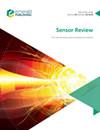Ultra sensitive determination of Cadmium (II) using Ag-Au BMNPs–aptamer–modified glassy carbon electrodes (GCE)
IF 1.4
4区 工程技术
Q3 INSTRUMENTS & INSTRUMENTATION
引用次数: 0
Abstract
Purpose The purpose of this study is determination of cadmium using silver-gold bimetallic nanoparticles (Ag-Au BMNPs) and an aptamer modified glassy carbon electrode. Design/methodology/approach The maximum response of modified electrode was obtained with, 50 mV pulse amplitude, 20 mV/s scan rate in phosphate buffer of pH 4.0. Ag-Au BMNPs, as the mediators improved electron transmit during the entire electron transfer process and the aptasensor response. Herein, the authors used aptamer as the capture probe to prepare an aptasensor with enhanced stability. Findings The proposed aptasensor exhibited a wide linearity to cadmium in the range of 0.001–0.100 µg/L with a low detection limit of 0.005×10 −3 µg/L. The glassy carbon electrodes with Ag-Au BMNPs showed a lower detection limit. Originality/value This aptasensor has good reproducibility, stability and repeatability and is cost-effective to regenerate. The specificity and selectivity of the novel modified electrode is tested in the presence of other interfering metal ions such as Fe 2+ , Mn 2+ , Mg 2+ , Sb 3+ and Bi 3+ . The aptasensor shows 10 times more sensitivity and selectivity for Cd 2+ ions.Ag-Au -适配体修饰玻碳电极超灵敏测定镉(II)
目的研究银金双金属纳米粒子(Ag-Au BMNPs)和适体修饰的玻碳电极测定镉的方法。在pH为4.0的磷酸盐缓冲液中,当脉冲振幅为50 mV,扫描速率为20 mV/s时,改性电极的响应最大。Ag-Au BMNPs作为介质,在整个电子传递过程中提高了电子传递率,提高了适体传感器的响应。本文采用适体作为捕获探针,制备了具有增强稳定性的适体传感器。在0.001 ~ 0.100µg/L的线性范围内,检测限低至0.005×10−3µg/L。Ag-Au BMNPs的玻碳电极检测限较低。原创性/价值该传感器具有良好的再现性、稳定性和可重复性,再生成本低。在fe2 +、mn2 +、mg2 +、sb3 +、bi3 +等干扰金属离子存在的情况下,测试了新型修饰电极的特异性和选择性。该传感器对cd2 +离子的灵敏度和选择性提高了10倍。
本文章由计算机程序翻译,如有差异,请以英文原文为准。
求助全文
约1分钟内获得全文
求助全文
来源期刊

Sensor Review
工程技术-仪器仪表
CiteScore
3.40
自引率
6.20%
发文量
50
审稿时长
3.7 months
期刊介绍:
Sensor Review publishes peer reviewed state-of-the-art articles and specially commissioned technology reviews. Each issue of this multidisciplinary journal includes high quality original content covering all aspects of sensors and their applications, and reflecting the most interesting and strategically important research and development activities from around the world. Because of this, readers can stay at the very forefront of high technology sensor developments.
Emphasis is placed on detailed independent regular and review articles identifying the full range of sensors currently available for specific applications, as well as highlighting those areas of technology showing great potential for the future. The journal encourages authors to consider the practical and social implications of their articles.
All articles undergo a rigorous double-blind peer review process which involves an initial assessment of suitability of an article for the journal followed by sending it to, at least two reviewers in the field if deemed suitable.
Sensor Review’s coverage includes, but is not restricted to:
Mechanical sensors – position, displacement, proximity, velocity, acceleration, vibration, force, torque, pressure, and flow sensors
Electric and magnetic sensors – resistance, inductive, capacitive, piezoelectric, eddy-current, electromagnetic, photoelectric, and thermoelectric sensors
Temperature sensors, infrared sensors, humidity sensors
Optical, electro-optical and fibre-optic sensors and systems, photonic sensors
Biosensors, wearable and implantable sensors and systems, immunosensors
Gas and chemical sensors and systems, polymer sensors
Acoustic and ultrasonic sensors
Haptic sensors and devices
Smart and intelligent sensors and systems
Nanosensors, NEMS, MEMS, and BioMEMS
Quantum sensors
Sensor systems: sensor data fusion, signals, processing and interfacing, signal conditioning.
 求助内容:
求助内容: 应助结果提醒方式:
应助结果提醒方式:


